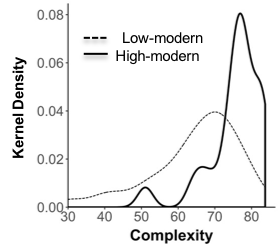More complex environments with expanded scope for stimulii to the brain have far reaching impact on various aspects of the brain. Sapien Labs’ Human Brain Diversity project shows that increasing stimulus consumption is associated with a systematic increase in the complexity of the EEG signal. These findings have far reaching implications for our understanding of income inequality.
The brain needs stimulus to develop and grow
Unlike most other organs which behave essentially the same from birth to death and are purely dependent on calories and nutrients for their growth and functioning, the brain must consume something else – stimulus. It is the stimulus from the external world that comes through the senses that is crucial for the sculpting of the brain’s wiring from birth into adulthood and beyond. It is this stimulus dependent neuroplasticity that determines the pruning of synapses, the formation of new synapses and the nature of activity that courses through the brain.
Animal studies have shown the enormous impact of different degrees of stimulus in the environment on the brain (for example see refs [1] though there is a vast literature). For instance, mice put into stimulus rich cages with wheels and mazes and a more complex set of objects in the environment exhibited a whole host of changes in neurogenesis, dendritic branching as well as gene expression. All of these changes impact brain physiology – the pathways for electrical activity and its structure.
Our changing stimulus environment
For humans the last 200 years have seen a remarkable increase in the complexity of our stimulus environment. The difference in the complexity of our present modern stimulus environment and that of our pre-modern counterparts is even more dramatic than the addition of a maze, a wheel and a few objects into the cage that so dramatically change mouse brains.
Literacy, numeracy and formal institutionalized education began to spread expanding the complexity and scope of knowledge we could consume. In 1870, the median years of education was around 2 years. Today it is around 8 years and almost half of the world has completed high school. The advent of motorized vehicles and air travel has fundamentally changed our ability to explore a wider range of environments dramatically expanding the average individual footprints in the world. Travel changes the pace and range of novel stimulus that we encounter from navigating novel spatial environments to communicating in new languages and interacting in different cultures. And more recently there is the cell phone and Internet which have changed the rate at which we can interact with others and the pace of our access to knowledge and information. Compare this to the pace of stimulus of a technology free life, lived on foot.
Income and Stimulus Consumption
 Yet not every part of the world has made the transition into modern life and many of these stimulus expanding factors cost money. With growing income inequality there is also growing stimulus inequality. At the very lowest end of income of $5 and under, most is spent on food and shelter. As income increases beyond this subsistence level, it is increasingly spent on acquiring these large stimulus expanding factors – education, cell phones, a vehicle and travel. The graph (from [2]) shows how stimulus consumption changes as a function of income – here stimulus consumption is a composite measure of education, travel, fuel consumption and cell phone use.
Yet not every part of the world has made the transition into modern life and many of these stimulus expanding factors cost money. With growing income inequality there is also growing stimulus inequality. At the very lowest end of income of $5 and under, most is spent on food and shelter. As income increases beyond this subsistence level, it is increasingly spent on acquiring these large stimulus expanding factors – education, cell phones, a vehicle and travel. The graph (from [2]) shows how stimulus consumption changes as a function of income – here stimulus consumption is a composite measure of education, travel, fuel consumption and cell phone use.
The relationship between income and stimulus consumption is logarithmic in nature. In India, somewhere in the range of $30 to $50/ day one can afford all of these stimulus expanding elements at the basic level.
EEG and Stimulus Consumption
We know from animal studies that dramatic changes in the stimulus environment cause dramatic changes in the brain. Further, in humans, stimulus consumption increases systematically with income [2] and previous studies have shown that those who grow up in poverty have structural differences in the brain [3]. How then does this reflect in the EEG?


Recent work from Sapien Labs’ Human Brain Diversity project looked at a wide range of people spanning a wide range of income and access to stimulus in India. Participants came from very remote ‘pre-modern’ ecosystems without cars, cell phones and schools with incomes <$3/day to urban hubs with university degrees, cars and cell phones. Perhaps shockingly complexity of the EEG measured in a resting eyes closed condition increased in lockstep with stimulus consumption. This measure of complexity essentially reflects the diversity of complex waveform patterns in the EEG signal. Between the lowest stimulus consumption group – essentially those living a ‘pre-modern’ life compared to those in the highest stimulus consumption group (urban digitally connected) was substantial.
From Complexity to Cognition
EEG waveform complexity is correlated with entropy measures and had high correlation with performance on a pattern recognition task [3]. Does this mean that the more stimulus we consume, the more we are enhanced cognitively?
Indeed, the well documented Flynn effect has shown that we as a collective humanity have been growing in our IQ score over the past one hundred years as our capability to consume stimulus has expanded with modern technologies and Institutions. We must ask however, what this means in the context of our diverging income, and therefore diverging access to stimulus. This is particularly poignant when the consequences are not just external but physiological.
References
[1] Nithianantharajah J, Hannan AJ. Enriched environments, experience-dependent plasticity and disorders of the nervous system. Nat Rev Neurosci. 2006
[2] Parameshwaran D. et al., The Impact of Socioeconomic and Stimulus Inequality on Human Brain Physiology Nature Scientific Report 2021
[3] Noble KG et al. Family income, parental education and brain structure in children and adolescents. Nat Neurosci. 2015
[4] Parameshwaran D, Thiagarajan TC. Waveform Complexity: A New Metric for EEG Analysis. J Neurosci Methods. 2019.
















